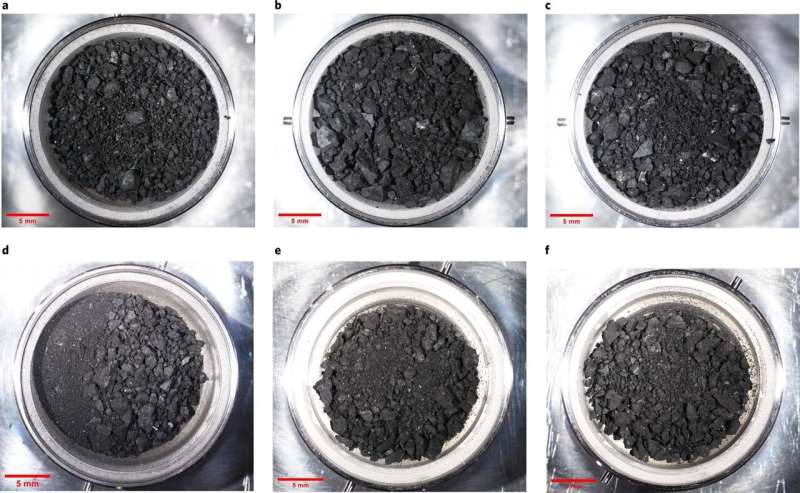A flowchart of a series of processes for the Hayabusa2 sample container and its catcher experienced after its landing. Note that samples inside the container were only exposed to vacuum and nitrogen environment in the clean chambers for Haybusa2-returned samples. Credit: DOI: 10.1038/s41550-021-01550-6
Two teams of researchers are publishing their findings thus far after initial study of samples collected from the asteroid Ryugu and returned to Earth last year by the Japanese space probe Hayabusa2. Both teams are large and both are made up mostly of researchers from institutions in Japan. Both teams have also published their findings in Nature Astronomy.
Hayabusa2 was launched in 2014 and rendezvoused with Ryugu in 2018. The following year, surface and sub-surface samples were collected from the asteroid and dropped via parachute to Earth in 2020. Hayabusa2 then continued on its way to study another asteroid.
Ryugu is a carbonaceous asteroid, and as its name suggests, is made mostly of carbon. It is one of the near-Earth asteroids that make up the Apollo group. In this new effort, the first team studied the density, particle size distribution and porosity of the samples. The second group focused exclusivity on its composition.
The first group found that the samples were darker in color than was expected. Pictures of the material look very much like tiny buckets of coal residue. Testing showed it reflected just 2% of solar radiation, making it less reflective than asphalt. They also found that its porosity was 46%, the highest ever found for an asteroid or meteorite. This finding suggested that if Ryugu was ever to merge paths with Earth, it would likely burn up in the atmosphere before ever hitting the ground.
The second group found that the samples were of a hydrated matrix of materials such as clay, along with a number of organic materials. They also found that some of the materials in the samples were not part of the matrix and contained materials such as carbonates or volatile compounds.
Together, the findings suggest that Ryugu is likely quite uniform on a macroscopic scale and resembles chondrites. The exception is its darkness and fragility. The researchers conclude the asteroid likely represents some of the most primordial material available for study in the lab—a feature that could help scientists learn more about the evolution of the solar system.
More information: Toru Yada et al, Preliminary analysis of the Hayabusa2 samples returned from C-type asteroid Ryugu, Nature Astronomy (2021). DOI: 10.1038/s41550-021-01550-6
C. Pilorget et al, First compositional analysis of Ryugu samples by the MicrOmega hyperspectral microscope, Nature Astronomy (2021). DOI: 10.1038/s41550-021-01549-z
Journal information: Nature Astronomy
© 2021 Science X Network
























